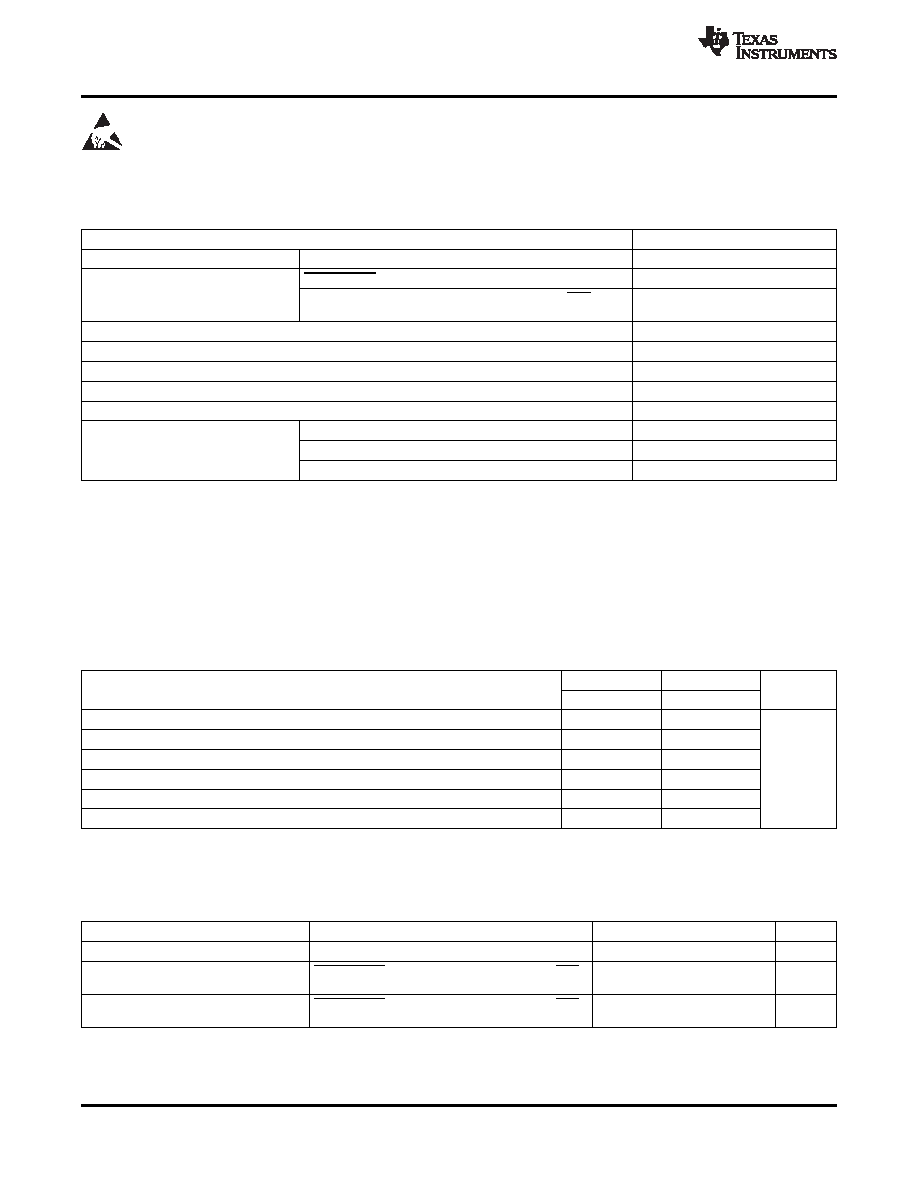- 您現(xiàn)在的位置:買賣IC網(wǎng) > PDF目錄98272 > TPA3101D2RGZRG4 (TEXAS INSTRUMENTS INC) 10 W, 2 CHANNEL, AUDIO AMPLIFIER, PQCC48 PDF資料下載
參數(shù)資料
| 型號: | TPA3101D2RGZRG4 |
| 廠商: | TEXAS INSTRUMENTS INC |
| 元件分類: | 音頻/視頻放大 |
| 英文描述: | 10 W, 2 CHANNEL, AUDIO AMPLIFIER, PQCC48 |
| 封裝: | 7 X 7 MM, GREEN, PLASTIC, VQFN-48 |
| 文件頁數(shù): | 12/41頁 |
| 文件大小: | 1073K |
| 代理商: | TPA3101D2RGZRG4 |
第1頁第2頁第3頁第4頁第5頁第6頁第7頁第8頁第9頁第10頁第11頁當前第12頁第13頁第14頁第15頁第16頁第17頁第18頁第19頁第20頁第21頁第22頁第23頁第24頁第25頁第26頁第27頁第28頁第29頁第30頁第31頁第32頁第33頁第34頁第35頁第36頁第37頁第38頁第39頁第40頁第41頁

SLOS473C – DECEMBER 2005 – REVISED SEPTEMBER 2007
www.ti.com
These devices have limited built-in ESD protection. The leads should be shorted together or the device placed in conductive foam
during storage or handling to prevent electrostatic damage to the MOS gates.
ABSOLUTE MAXIMUM RATINGS
over operating free-air temperature range (unless otherwise noted)
(1)
UNIT
VCC
Supply voltage
AVCC, PVCC
–0.3 V to 30 V
SHUTDOWN, MUTE
–0.3 V to VCC + 0.3 V
VI
Input voltage
GAIN0, GAIN1, RINN, RINP, LINN, LINP, MSTR/SLV,
–0.3 V to VREG + 0.5 V
SYNC
Continuous total power dissipation
See Thermal Information Table
TA
Operating free-air temperature range
–40°C to 85°C
TJ
Operating junction temperature range(2)
–40°C to 150°C
Tstg
Storage temperature range
–65°C to 150°C
R(Load)
Load Resistance
3.2
Minimum
Human body model (3) (all pins)
±2 kV
Electrostatic discharge
Machine model (4) (all pins)
±200 V
Charged-device model (5) (all pins)
±500 V
(1)
Stresses beyond those listed under absolute maximum ratings may cause permanent damage to the device. These are stress ratings
only, and functional operations of the device at these or any other conditions beyond those indicated under recommended operating
conditions is not implied. Exposure to absolute-maximum-rated conditions for extended periods may affect device reliability.
(2)
The TPA3101D2 incorporates an exposed thermal pad on the underside of the chip. This acts as a heatsink, and it must be connected
to a thermally dissipating plane for proper power dissipation. Failure to do so may result in the device going into thermal protection
shutdown. See TI Technical Briefs SCBA017D and SLUA271 for more information about using the QFN thermal pad. See TI Technical
Briefs SLMA002 for more information about using the HTQFP thermal pad.
(3)
In accordance with JEDEC Standard 22, Test Method A114-B.
(4)
In accordance with JEDEC Standard 22, Test Method A115-A
(5)
In accordance with JEDEC Standard 22, Test Method C101-A
THERMAL INFORMATION
PHP
RGZ
THERMAL METRIC(1) (2)
UNITS
48 (PINS)
qJA
Junction-to-ambient thermal resistance
28.5
26.4
qJCtop
Junction-to-case (top) thermal resistance
19
qJB
Junction-to-board thermal resistance
10.5
14.4
°C/W
yJT
Junction-to-top characterization parameter
0.3
0.2
yJB
Junction-to-board characterization parameter
6.4
6.3
qJCbot
Junction-to-case (bottom) thermal resistance
0.7
1.7
(1)
For more information about traditional and new thermal metrics, see the IC Package Thermal Metrics application report, SPRA953.
(2)
For thermal estimates of this device based on PCB copper area, see the TI PCB Thermal Calculator.
RECOMMENDED OPERATING CONDITIONS
over operating free-air temperature range (unless otherwise noted)
PARAMETER
TEST CONDITIONS
MIN
MAX
UNIT
VCC
Supply voltage
PVCC, AVCC
10
26
V
SHUTDOWN, MUTE, GAIN0, GAIN1, MSTR/SLV,
VIH
High-level input voltage
2
V
SYNC
SHUTDOWN, MUTE, GAIN0, GAIN1, MSTR/SLV,
VIL
Low-level input voltage
0.8
V
SYNC
2
Copyright 2005–2007, Texas Instruments Incorporated
Product Folder Link(s): TPA3101D2
相關PDF資料 |
PDF描述 |
|---|---|
| TPA3101D2RGZR | 10 W, 2 CHANNEL, AUDIO AMPLIFIER, PQCC48 |
| TPA3101D2RGZTG4 | 10 W, 2 CHANNEL, AUDIO AMPLIFIER, PQCC48 |
| TPA3101D2RGZT | 10 W, 2 CHANNEL, AUDIO AMPLIFIER, PQCC48 |
| TPA3101D2PHPR | 10 W, 2 CHANNEL, AUDIO AMPLIFIER, PQFP48 |
| TPA3101D2PHP | 10 W, 2 CHANNEL, AUDIO AMPLIFIER, PQFP48 |
相關代理商/技術參數(shù) |
參數(shù)描述 |
|---|---|
| TPA3101D2RGZT | 功能描述:音頻放大器 10-W Stereo Class-D Aud Power Amplifier RoHS:否 制造商:STMicroelectronics 產(chǎn)品:General Purpose Audio Amplifiers 輸出類型:Digital 輸出功率: THD + 噪聲: 工作電源電壓:3.3 V 電源電流: 最大功率耗散: 最大工作溫度: 安裝風格:SMD/SMT 封裝 / 箱體:TQFP-64 封裝:Reel |
| TPA3101D2RGZTG4 | 功能描述:音頻放大器 10-W Stereo Class-D Aud Power Amplifier RoHS:否 制造商:STMicroelectronics 產(chǎn)品:General Purpose Audio Amplifiers 輸出類型:Digital 輸出功率: THD + 噪聲: 工作電源電壓:3.3 V 電源電流: 最大功率耗散: 最大工作溫度: 安裝風格:SMD/SMT 封裝 / 箱體:TQFP-64 封裝:Reel |
| TPA3106D1 | 制造商:TI 制造商全稱:Texas Instruments 功能描述:40-W MONO CLASS-D AUDIO POWER AMPLIFIER |
| TPA3106D1EVM | 功能描述:音頻 IC 開發(fā)工具 TPA3106D1EVM Eval Mod RoHS:否 制造商:Texas Instruments 產(chǎn)品:Evaluation Kits 類型:Audio Amplifiers 工具用于評估:TAS5614L 工作電源電壓:12 V to 38 V |
| TPA3106D1EVM | 制造商:Texas Instruments 功能描述:EVAL BOARD, TPA3106D1 40W, CLASS D POWER |
發(fā)布緊急采購,3分鐘左右您將得到回復。